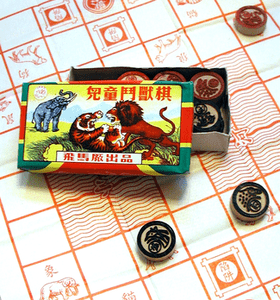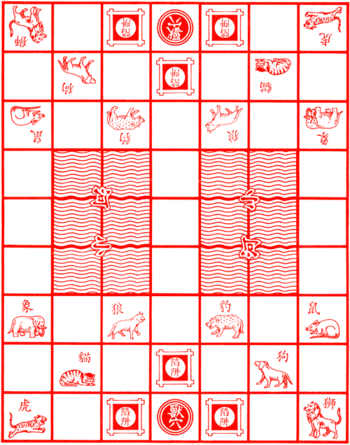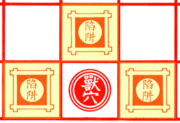
- Tabletop games
- Board games
- Tile-based games
- Turn-based games.html
- Abstract strategy games
- card games
- Connection games
- Mancala games
- Paper-and-pencil games
- Word games



| 鬥獸棋 (Dou Shou Qi) | |
|---|---|

A typical and inexpensive Jungle set with paper board, purchased at a Chinese stationery shop
|
|
| Genre(s) | Board game Abstract strategy game |
| Players | 2 |
| Age range | 5+ |
| Playing time | 5-30 minutes |
| Random chance | None |
| Skill(s) required | Strategy, tactics, counting |
| Synonym(s) | Dou Shou Qi The Jungle Game Jungle Chess Animals Chess Oriental Chess Children's Chess |
Jungle or Dou Shou Qi (Chinese: 鬥獸棋, "Game of Fighting Animals") is a traditional Chinese board game played on a 7x9 board. The game is also known as The Jungle Game, Jungle Chess, or Animals Chess, and is sometimes called Oriental Chess or Children's Chess.
Jungle is a two-player strategy game and has been cited as resembling the Western game Stratego, but Stratego actually has more in common with another Chinese board game known as Jun Qi (Chinese: 軍棋) or "Army Game".
The goal of the game is either to move a piece onto a special square, the den, on the opponent's side of the board, or capture all of the opponent's pieces.
The Jungle gameboard consists of seven columns and nine rows of squares. Pieces move on the square spaces as in international chess, not on the lines as in xiangqi. Pictures of eight animals and their names appear on each side of the board to indicate initial placement of the game pieces. After initial setup, these animal spaces have no special meaning in gameplay.
There are several special squares and areas of the Jungle board: The den (獸穴; pinyin: shòu xuè, "lair") is located in the center of the first row or rank of the board, and is labeled as such in Chinese. Traps (陷阱; pinyin: xiàn jǐng, "snare") are located to each side and in front of the den, and are also labeled in Chinese. Two water areas or rivers (河川; pinyin: hé chuān, "river") are located in the center of the Jungle board. Each comprises six squares in a 2x3 rectangle, and labeled with the Chinese characters for "river". There are single columns or files of ordinary land squares on the edges of the board, and down the middle between the rivers.
 The den highlighted in green
The den highlighted in green |
 A typical Jungle gameboard showing the location of starting squares, the den, rivers, and traps
A typical Jungle gameboard showing the location of starting squares, the den, rivers, and traps |
 The traps highlighted in yellow
The traps highlighted in yellow |
|
 One of the rivers
One of the rivers |
Each side has eight pieces representing different animals, each with a different rank. Higher ranking pieces can capture all pieces of identical or weaker ranking. However, there is one exception: The rat may capture the elephant, while the elephant may or may not capture the rat (depending on the variant). The animal ranking, from strongest to weakest, is:
| Rank | Piece | |
|---|---|---|
| 8 | Elephant | Chinese: 象; pinyin: xiàng |
| 7 | Lion | Chinese: 獅; pinyin: shī |
| 6 | Tiger | Chinese: 虎; pinyin: hǔ |
| 5 | Leopard | Chinese: 豹; pinyin: bào |
| 4 | Wolf | Chinese: 狼; pinyin: láng |
| 3 | Dog | Chinese: 狗; pinyin: gǒu |
| 2 | Cat | Chinese: 貓; pinyin: māo |
| 1 | Rat | Chinese: 鼠; pinyin: shǔ |
Pieces are placed onto the corresponding pictures of the animals which are invariably shown on the Jungle board.
Players alternate moves with White moving first. During their turn, a player must move. Each piece moves one square horizontally or vertically (not diagonally). A piece may not move to its own den.
There are special rules related to the water squares:
Animals capture the opponent pieces by "eating" them. A piece can capture any enemy piece which has the same or lower rank, with the following exceptions:
There are some commonly played variations to the rules official published by the board/pieces maker as follows: